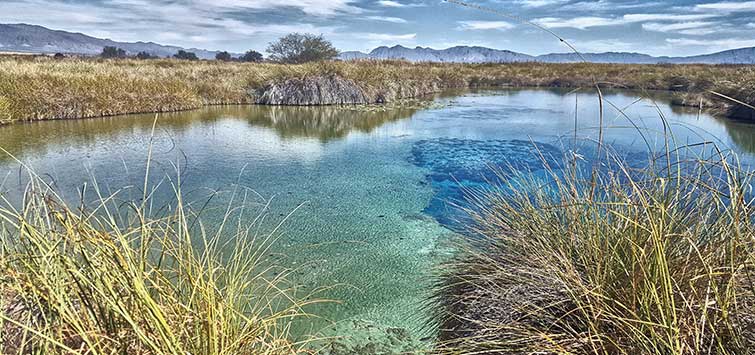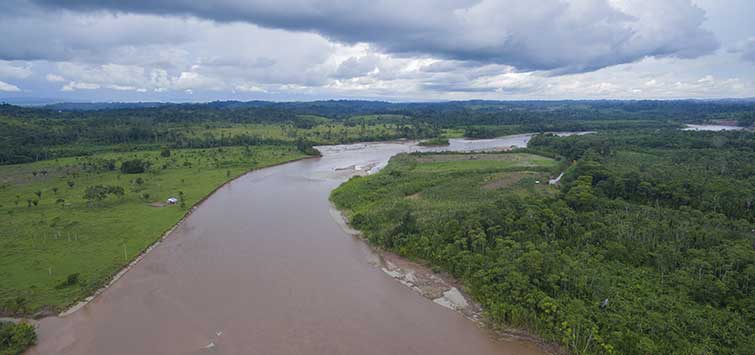Three Weeks South of the Border: My Mexico Livebearer Experience
Author: Rit Forcier
The Chairman of the American Livebearer Association details his fish-collecting trip to Mexico, where he found some longtime livebearer favorites in their natural habitats.
My Journey Through Mexico
This past October I had the very good fortune to spend three weeks in Mexico collecting and learning about native livebearers and their habitats. It was truly the trip of a lifetime in many ways. Given that few of us get such a privilege, and that this is the American Livebearer Association (ALA) Convention issue of Tropical Fish Hobbyist, I present here a brief pictorial and overview of this wonderful expedition south of the border.
Planning the Trip
The expedition itself was the brainchild of Ivan Dibble, noted British livebearer guru and head of the Hobbyists Aquatic Livebearer Conservation Program (HALCP), more commonly referred to as Project Fish Ark Mexico. Ivan has been to Mexico several times and knows his way around. Also joining us were Tom Crane, ALA species maintenance chairman from New Jersey; Don Kenwood, treasurer of the British Livebearer Association; and Christian Keller Santandera and his significant other, Sandy. Christian was recently elected vice chairman of a livebearer group in France called Association France Vivipare.
Like a Kid Again
From the beginning I felt like a kid off to his first summer camp. I asked questions of just about everyone I could contact. Even then, I certainly did not plan everything well enough in advance. In retrospect, I could have improved my gear, my Mexican geography, and my knowledge of site details. I had an adequate list of things to bring, and made all my travel plans with plenty of time to spare, but the item I really could have used during the trip was a good pair of lightweight hip waders!
Lessons Learned
There were some sites where it just did not make sense to wade in a swimsuit and scuba booties. Certainly, the water temperature was fine and I was never really cold, but the water was a bit too dirty in some locations for my taste. My biggest relief was that my collecting nets were just as good as (or even better than) the others that were being used. I took some good advice and got the sturdiest net that the supplier had in stock. The seine worked really well also, since a lot of the fish in open water swim faster than I could move the net.
A Geography Lesson
Next time I intend to do a better job of researching collecting sites so I know what to expect from my collection. The geography lesson involved maps; I depended on my trusty countrywide road map. Ivan had better maps, but they were still street maps, and sometimes they lacked the information about smaller bodies of water. Somewhere we will secure a good topographical map.
Brushing Up on My Spanish
I had practiced my Spanish well enough in advance. It really helps to know some of the local language, but it was not a necessity for this trip. Most of the folks we visited spoke English well enough to communicate. And Ivan had secured the services of a local college student to be our driver and interpreter. His name was Roberto Chavarria, and he was a great person to have come along.
I also spoke a lot of French with Christian, and surprised myself how much I remembered from my college days.
Trip Overview
The trip itself can be generalized into three parts, each lasting about a week. The first week was in the Monterrey area and to the north. Week two was south of Monterrey. The final part of the trip was spent in Morelia.
Week One
We all flew into Monterrey, and Don, Ivan, and I actually hooked up in Houston for the final leg of the inbound flight. Week one started with work and visits in and around Monterrey, a huge industrial city only 100 miles west of the southern part of Texas. Our first and foremost objective here was to meet and establish a relationship with the University of Nuevo Leone, which has a lab run by Dr. Arcadio Valdes Gonzales, a gentleman known to many of us in the hobby.
Arcadio introduced us to Dr. Jose Santos Garcia, the Dean of the School of Biology. Although our initial attempt to set up “Fish Ark II” was not entirely successful, progress was made. The killifish keepers should get involved with this endeavor, as Arcadio does as much, if not more, with Cyprinodon species as he does with livebearers.
Searching for Xiphophorus species, we ventured north via minivan to an area where we thought we could find them. We drove through Monclova and headed for Cuatro CiÉnegas. Roberto served as our interpreter and driver, and he used his local contacts to find out that there are federal conservation officers in the National Park area watching out for those who might try to collect without permits. Some of the local folks also told us that X. gordoni is gone, the pond having been dried up for several consecutive years. We decided against other stops and headed back toward Monterrey.
One of the more interesting stops was at Huasteca Canyon. Once an important source of water and recreation, it is now just a dry park near the center of town. As the story goes, the town grew and the people needed more drinking water. As more wells were dug and more water consumed, the spring actually shrunk. It dried up completely in the 1990s, and the Monterrey platy Xiphophorus couchianus is now completely gone, except for those in public aquaria or the tanks of fishkeepers. We were amazed to see the remains of the spring, which reminded me of the skeleton of some dead animal in the desert. We paid 10 pesos (about $1) to get in and it was certainly worth it.
Week Two
During the second week our contingent drove south from Monterrey via Route 85 and visited most of the important fish sites in Central Mexico. I quickly learned how not to collect fish in the wild. At one location with a steep riverbank I slipped and fell in because my scuba footwear gave me no traction. You may never see that photo.
My experiences, although somewhat limited, did pay off and we did find many interesting (but not new) species. Our 30-plus stops were too numerous to mention without many boring details. Suffice it to say that we were able to assess the availability of many species, including several non-livebearer fish, such as a popular Astyanax species of tetra (characin). We also caught Herichthys cichlids. We ventured through so many towns that, without a lot of detail, the narrative would read like the stops on a New York City subway train. And, perhaps similarly, the Mexican waterways, both the banks and beds, were littered with trash; the amount of refuse that people had left was really disappointing.
One of the highlights was the visit to Rio Tamasopo Falls and collecting the wild Montezuma swordtail. It really is a pretty area, replete with private (and well-maintained) campgrounds. The falls themselves are fascinating. The river divides into three fingers up above on the plateau, and the water cascades almost straight down over 60 feet into the pool in the campground. I really wanted to join the kids in the swimming area!
Sandy and Ivan usually handled the cameras during the stops while we would do our exploration. At the end of each stop Christian would spend the final 15 minutes conducting a detailed water analysis. While he did his chemistry measures, Ivan would write some notes and take a GPS reading, Roberto would pack up the car, and I would be storing any relevant specimens and snapping a few photos to recap. We made a pretty good team.
The other important event was the one that did not happen; I never fell victim to any gastro-intestinal problems on the trip. Early on I avoided any leafy vegetable and all local water. I even brushed my teeth with bottled water! Toward the end I was less careful, but never sick. My favorite dish on the trip—and my preference was shared by Ivan—was, most surprisingly, the guacamole in Morelia. Back home it is as flavorless as wallpaper paste in comparison.
Week Three: Our Last Chance
The final week was spent in Morelia, a colonial town about 100 miles from Puerto Vallarta. It is the provincial capital of the state of Michoacan and a great place to visit. I was immediately reminded of stories of Sixteenth Century Spain. There are no beaches, mind you, but plenty to see and do. A good-sized zoo attracts tourists to the south side of town. The weekend festivals start on Friday and proceed through Sunday night, and they seem to occur almost every weekend. It also boasts one of the oldest universities in the New World.
One of our main objectives was to visit the Morelia Aqua Lab, where we spent much time and held many a conversation with both Rebeca Aneli Rueda Jasso and Omar Dominguez Dominguez. Thanks to Project Fish Ark Mexico, I had seen many photos of the start of the lab. Regardless, I was amazed at the expansiveness and variety of livebearers—I was truly in Livebearer Heaven! The staff was friendly and helpful, and one even joined us on an excursion to neighboring towns and different bodies of water. If you ever get the opportunity to visit the area, the lab is a must-see for any aquarist. But whether you’re the aquarist or tourist type, a visit to PÁtzcuaro is worth the trip. The open-air market has everything from souvenirs to groceries, tools to wedding dresses—and fish. Both freshly caught and dried fish were laid out on wooden tables for sale. I bought some that had been rolled in corn flour and dried in the sun. They might have been Ilyodon species.
While in Morelia, our group attended the Third International Symposium on Viviparous Fishes. This convention, held about every three years, brought the academic community together from 18 countries for four days of talks and tours. I thought I knew a lot about livebearers before attending, but I learned a lot. My knowledge of goodeid anatomy certainly got a boost.
I also made a lot of contacts and met several other members of the American Livebearer Association. The group included Dr. John Worums and Gil Rosenthal, who was the 1999 recipient of the ALA’s Vern Parish Scholarship award. I also met Leona Hazlewood of The Xiphophorus Genetic Stock Center, plus some folks from DGLZ, the German club; and some from Poecilia Scandinavia who really know how to attend a conference! The ALA also gained from this, as I was able to ask some folks to consider speaking at the annual convention.
Final Reflections
In the end, I returned home with 18 fish, including several livebearer species I had never kept, over 300 photos, and many experiences I will never forget. I hope to return one day, maybe sooner rather than later, if time and finances allow. For sure, it was the trip of a lifetime.

.png?h=595&iar=0&w=2781&hash=5FD5E69473BCC22199FBFA2FB71B6033)



